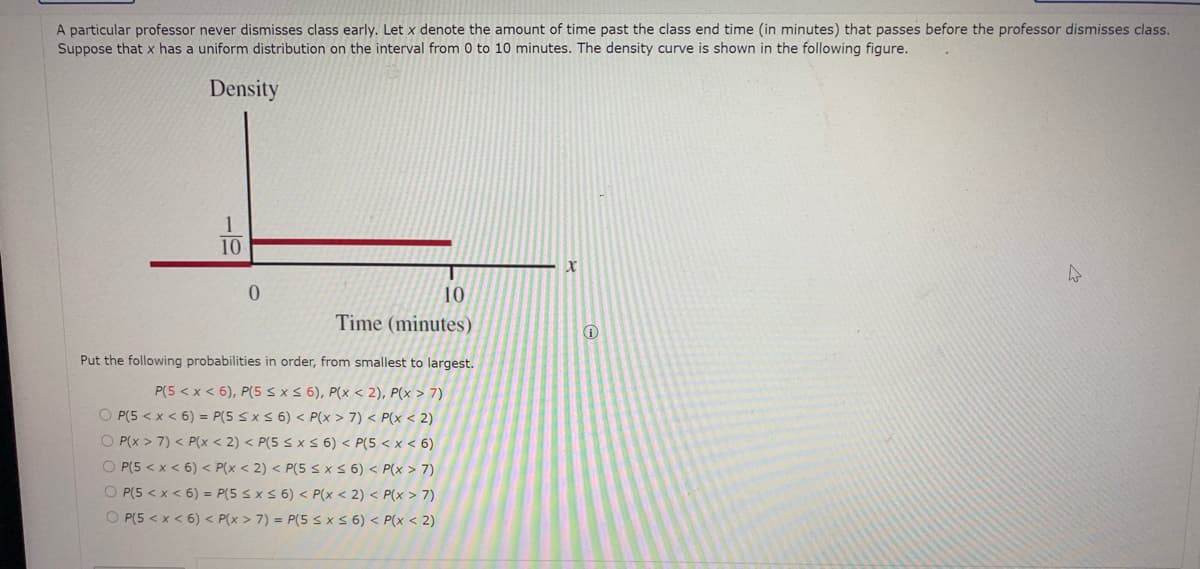A particular professor never dismisses class early. Let x denote the amount of time past the class end time (in minutes) that passes before the professor dismisses class. Suppose that x has a uniform distribution on the interval from 0 to 10 minutes. The density curve is shown in the following figure. Density 10 10 Time (minutes) Put the following probabilities in order, from smallest to largest. P(5 < x < 6), P(5 S xS 6), P(x < 2), P(x > 7) O P(5 < x < 6) = P(5 SxS 6) < P(x > 7) < P(x < 2) O P(x > 7) < P(x < 2) < P(5 < x S 6) < P(5 < x < 6) O P(5 < x < 6) < P(x < 2) < P(5sxS 6) < P(x > 7) O P(5 7) O P(5 < x < 6) < P(x > 7) = P(5sxS 6) < P(x < 2)
A particular professor never dismisses class early. Let x denote the amount of time past the class end time (in minutes) that passes before the professor dismisses class. Suppose that x has a uniform distribution on the interval from 0 to 10 minutes. The density curve is shown in the following figure. Density 10 10 Time (minutes) Put the following probabilities in order, from smallest to largest. P(5 < x < 6), P(5 S xS 6), P(x < 2), P(x > 7) O P(5 < x < 6) = P(5 SxS 6) < P(x > 7) < P(x < 2) O P(x > 7) < P(x < 2) < P(5 < x S 6) < P(5 < x < 6) O P(5 < x < 6) < P(x < 2) < P(5sxS 6) < P(x > 7) O P(5 7) O P(5 < x < 6) < P(x > 7) = P(5sxS 6) < P(x < 2)
MATLAB: An Introduction with Applications
6th Edition
ISBN:9781119256830
Author:Amos Gilat
Publisher:Amos Gilat
Chapter1: Starting With Matlab
Section: Chapter Questions
Problem 1P
Related questions
Question
5

Transcribed Image Text:A particular professor never dismisses class early. Let x denote the amount of time past the class end time (in minutes) that passes before the professor dismisses class.
Suppose that x has a uniform distribution on the interval from 0 to 10 minutes. The density curve is shown in the following figure.
Density
10
10
Time (minutes)
Put the following probabilities in order, from smallest to largest.
P(5 < x < 6), P(55 x5 6), P(x < 2), P(x > 7)
O P(5 < x < 6) = P(5 S x S 6) < P(x > 7) < P(x < 2)
O P(x > 7) < P(x < 2) < P(5 < x S 6) < P(5 < x < 6)
O P(5 < x < 6) < P(x < 2) < P(5 s x5 6) < P(x > 7)
O P(5 < x < 6) = P(5 s x s 6) < P(x < 2) < P(x > 7)
O P(5 < x < 6) < P(x > 7) = P(55xS 6) < P(x < 2)
Expert Solution
This question has been solved!
Explore an expertly crafted, step-by-step solution for a thorough understanding of key concepts.
This is a popular solution!
Trending now
This is a popular solution!
Step by step
Solved in 2 steps with 1 images

Recommended textbooks for you

MATLAB: An Introduction with Applications
Statistics
ISBN:
9781119256830
Author:
Amos Gilat
Publisher:
John Wiley & Sons Inc

Probability and Statistics for Engineering and th…
Statistics
ISBN:
9781305251809
Author:
Jay L. Devore
Publisher:
Cengage Learning

Statistics for The Behavioral Sciences (MindTap C…
Statistics
ISBN:
9781305504912
Author:
Frederick J Gravetter, Larry B. Wallnau
Publisher:
Cengage Learning

MATLAB: An Introduction with Applications
Statistics
ISBN:
9781119256830
Author:
Amos Gilat
Publisher:
John Wiley & Sons Inc

Probability and Statistics for Engineering and th…
Statistics
ISBN:
9781305251809
Author:
Jay L. Devore
Publisher:
Cengage Learning

Statistics for The Behavioral Sciences (MindTap C…
Statistics
ISBN:
9781305504912
Author:
Frederick J Gravetter, Larry B. Wallnau
Publisher:
Cengage Learning

Elementary Statistics: Picturing the World (7th E…
Statistics
ISBN:
9780134683416
Author:
Ron Larson, Betsy Farber
Publisher:
PEARSON

The Basic Practice of Statistics
Statistics
ISBN:
9781319042578
Author:
David S. Moore, William I. Notz, Michael A. Fligner
Publisher:
W. H. Freeman

Introduction to the Practice of Statistics
Statistics
ISBN:
9781319013387
Author:
David S. Moore, George P. McCabe, Bruce A. Craig
Publisher:
W. H. Freeman